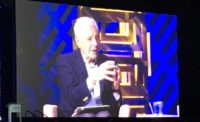Greenbuild Dispatch Day Two: Plenty of Good News at Celebration Party



That the Greenbuild 2015 celebration party was held at Washington, D.C.’s Newseum — a 2008 building by Polshek Partnership Architects (now Ennead) that sits across the street from the city’s monumental core — shouldn’t have been much of a surprise. Aside from being among the few locations within walking distance of the Walter E. Washington Convention Center that could accommodate the crowd and offer a terrific view of the city, it was an eye-catching reminder that, as one attendee put it, “D.C. isn’t just a city of marble columns.”
If an informal poll of a few dozen partygoers suggested anything, it’s that the USGBC crowd, from new members to diehard early LEED adopters, remains largely positive about how the movement is growing. Jon Penndorf, a senior associate and sustainability leader at the D.C. office of Perkins+Will, expressed pleasure at how the conference’s educational content has moved over the years beyond the purely tectonic to broader, more human-focused areas. “I went to a presentation on circadian rhythms today,” he said with mild amazement.
But not everyone was quite so bullish. One woman, a longtime member who moved several years ago from an architecture firm to a federal agency, spoke on condition of anonymity about how the green successes she had in the private sector were harder to find on the government side. Her disappointment with that fact was almost palpable, pointing to just one of the many challenges the organization still faces.
Mahesh Ramanujam, currently USGBC chief operating officer and recently tapped to take the reins in January 2017 when he will replace Rick Fedrizzi as CEO, seemed almost as much of a draw for guests as the Newseum’s various exhibitions. Maintaining an approachable demeanor, he shook hands and indulged in brief chats with guests and well-wishers all evening.
“The energy at Greenbuild this year has been inspiring,” said Ramanujam. “We are really stepping up the game.” Referencing the growth of the evidence-based WELL Building Standard, he added: “The Industrial Revolution was transformative because it took advantage of available resources. In the 21st century, data is freely available, and we are leveraging it for change.”
As the conversation ended and Ramanujam turned to greet a growing queue, he smiled and said, “Thank you for being a leader.”
Love the @Newseum after hours! Ready for @FitzAndTantrums to come on. #Greenbuild @Kohler. @DVGBC pic.twitter.com/u6lm3YHfFK
— Holly Shields (@DVGBCHolly) November 20, 2015








